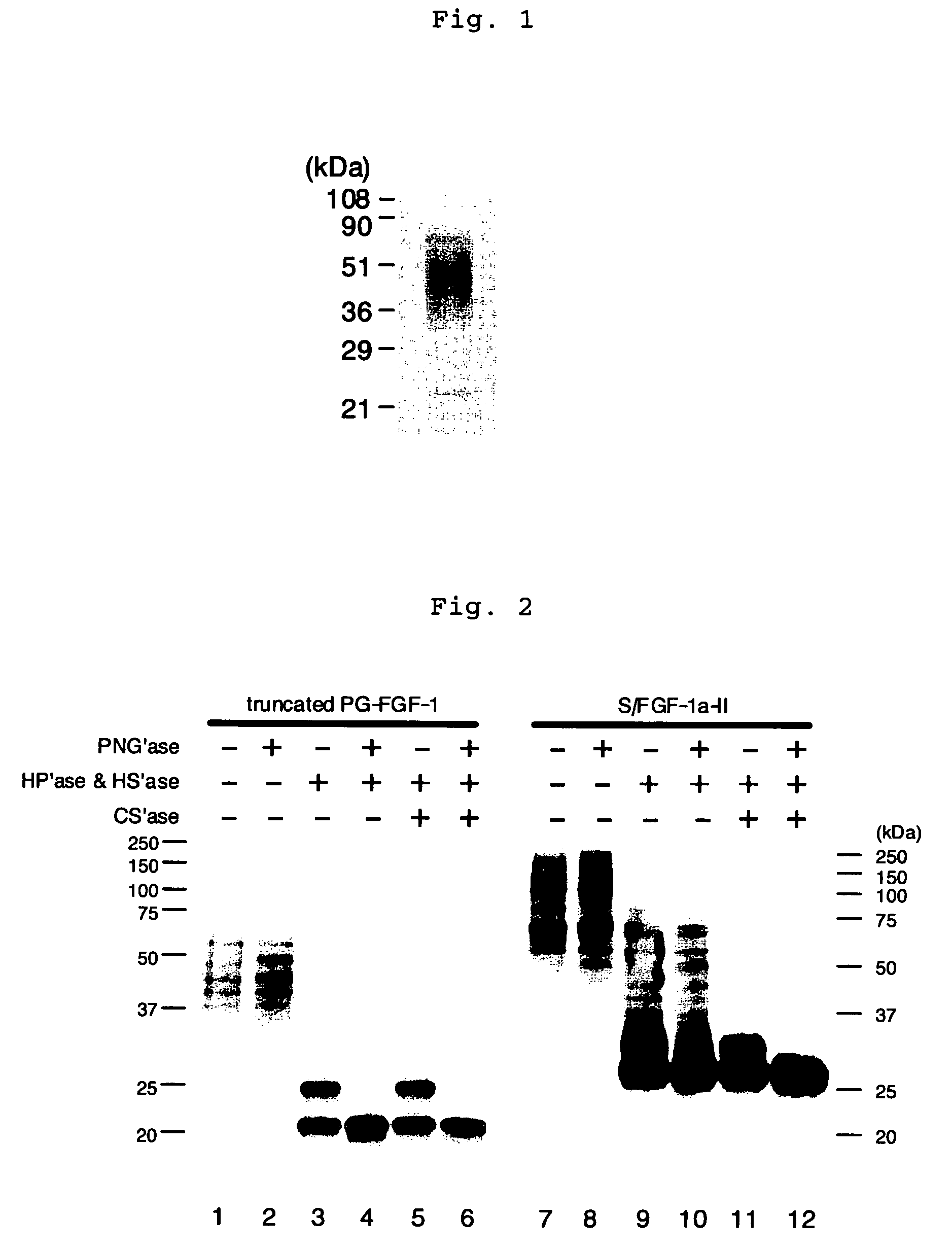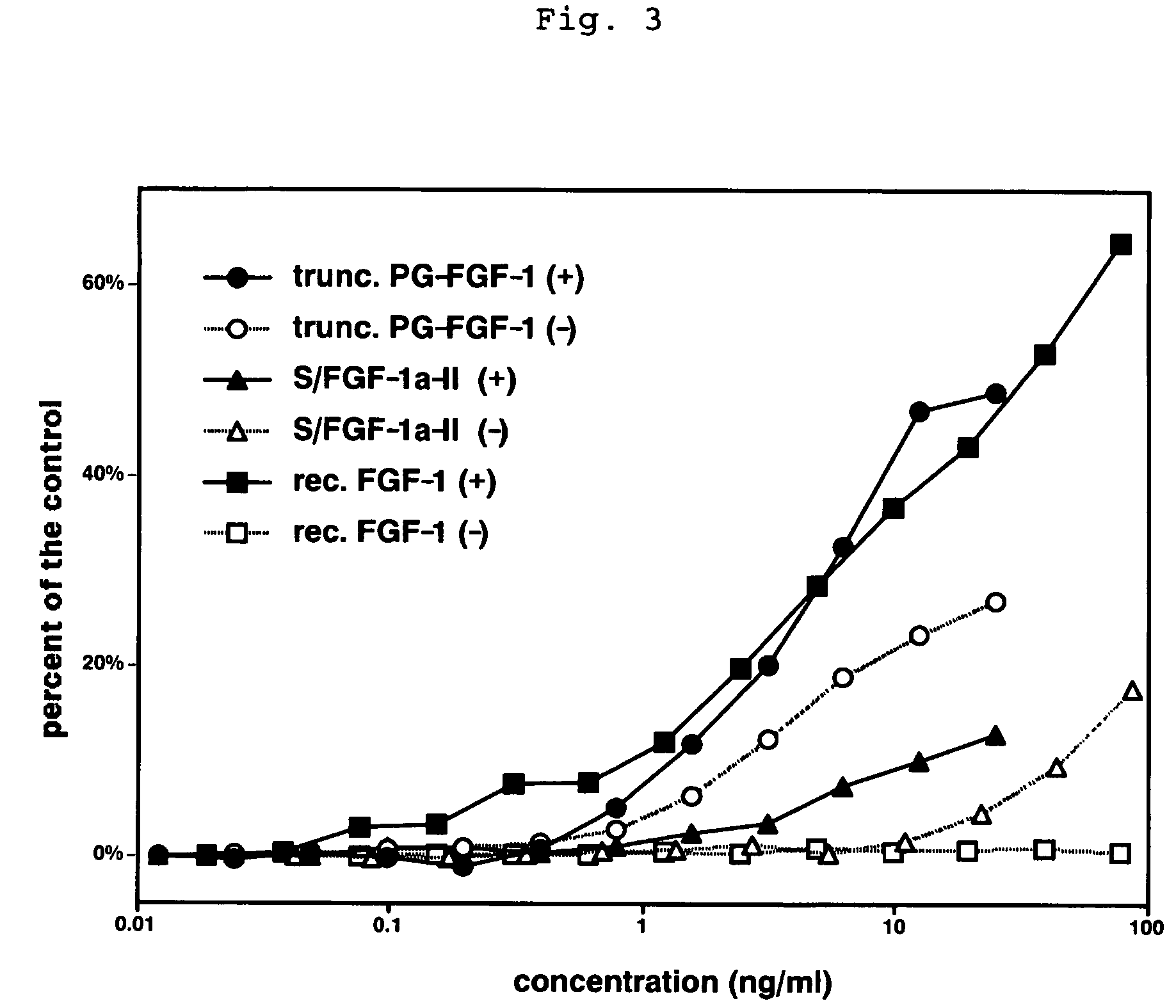Heparin-binding protein modified with heparan sulfate sugar chains, process for producing the same and pharmaceutical compositions containing the same
a technology of heparin and sulfate, which is applied in the direction of drug compositions, peptides, cardiovascular disorders, etc., can solve the problems of limited expected augmentation of protein function, and achieve the effect of high-quality improvement of function
- Summary
- Abstract
- Description
- Claims
- Application Information
AI Technical Summary
Benefits of technology
Problems solved by technology
Method used
Image
Examples
reference example 1
Construction of S / FGF-1a-II / pMEXneo Plasmid
1) Construction of S / FGF-1a-II Plasmid
1. Preparation of a Human Ryudocan cDNA Fragment
[0065]phR7A8 is a plasmid obtained by inserting a human ryudocan cDNA (PCR product) into the EcoR V site of pBluescript II (KS+) cloning vector. This plasmid contains a partial sequence from position 7 to position 2610 of the mRNA sequence as shown under Accession No. D13292 (see B.B.R.C. Vol. 190, No. 3, pp. 814-822, 1993). This plasmid was digested with Pvu II. Using the resultant DNA fragment of 2,232 base pairs as a template, a PCR (polymerase chain reaction) was performed. As primers, #109 (5′-TTG TCG ACC CAC CAT GGC CCC CGC CCG TCT-3′) (SEQ ID NO: 15) and #111 (5′-TTG ATA TCT AGA GGC ACC AAG GGA TG-3′) (SEQ ID NO: 16) were used. The specifically amplified 276 bp band was separated by electrophoresis, extracted and double-digested with EcoR V and Sal I. The resultant 268 bp band was separated, extracted and then used in the ligation described below.
2....
example 1
Preparation of trunc. PG-FGF-1 Protein
1. Construction of Trunc. PG-FGF-1 Plasmid
(1) Construction of a Gene for the Former Part of Trunc. PG-FGF-1
[0068]Using S / FGF-1a-II / pMEXneo plasmid (Reference Example 1) as a template, a PCR (polymerase chain reaction) was performed. As primers, #117 (5′-tcttccgatagactgcgtcg-3′) (SEQ ID NO: 1) and #645 (5′-gtaattagctacatcctcatcgtctgg-3′) (SEQ ID NO: 2) were used. A specifically amplified 200 bp band was separated by electrophoresis and extracted.
[0069]The DNA sequence of the coding region carried by S / FGF-1a-II / pMEXneo plasmid is shown in SEQ ID NO: 11. This sequence encodes a protein having the amino acid sequence as shown in SEQ ID NO: 12 in mammal cells.
(2) Construction of a Gene for the Latter Part of Trunc. PG-FGF-1
[0070]Using S / FGF-1a-II / pMEXneo plasmid as a template, a PCR was performed. As primers, #646 (5′-gaggatgtagctaattacaagaagccca-3′) (SEQ ID NO: 3) and #118 (5′-cattctagttgtggtttgtcc-3′) (SEQ ID NO: 4) were used. A specifically ampli...
PUM
| Property | Measurement | Unit |
|---|---|---|
| humidity | aaaaa | aaaaa |
| humidity | aaaaa | aaaaa |
| pH | aaaaa | aaaaa |
Abstract
Description
Claims
Application Information
 Login to View More
Login to View More - R&D
- Intellectual Property
- Life Sciences
- Materials
- Tech Scout
- Unparalleled Data Quality
- Higher Quality Content
- 60% Fewer Hallucinations
Browse by: Latest US Patents, China's latest patents, Technical Efficacy Thesaurus, Application Domain, Technology Topic, Popular Technical Reports.
© 2025 PatSnap. All rights reserved.Legal|Privacy policy|Modern Slavery Act Transparency Statement|Sitemap|About US| Contact US: help@patsnap.com


